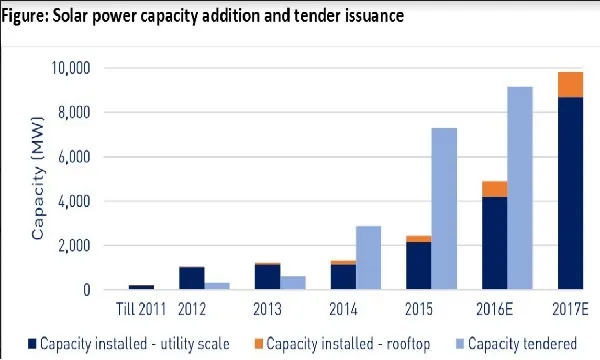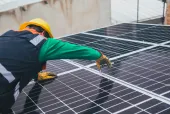
This chart shows why the best is yet to come for India's solar power sector
Total new capacity addition of 9GW is being expected come 2017.
Bridge to India said that key highlights in the sector over the year include record project volumes – both for capacity addition and issue of new tenders, improving power distribution company (DISCOM) financial position as a result of UDAY scheme, steep fall in equipment prices, improving M&A activity and India’s ratification of climate accord adding credibility to the country’s ambitious 100 GW target for 2022.
The year has been bountiful in all respects for the sector with most key indicators growing 2-3x over last year. The country added total solar capacity of 4.9 GW (estimated), an increase of 101% over 2015 and crossed the 10 GW cumulative installed capacity mark. New tenders were floated for 9 GW of grid connected solar projects including 900 MW for rooftop solar systems.
As solar tariffs fell below INR 5 (USD 0.07)/ kWh, solar power gained parity with other sources of greenfield power.
Falling cost has been instrumental in boosting solar demand from the DISCOMs despite total power demand staying relatively weak throughout the year.
Both Solar Energy Corporation of India (SECI) and National Thermal Power Corporation (NTPC) are expected to allocate substantial new capacity in 2017 attracting even more competitive tariff bids. "We expect the INR 4 tariff level to be breached in early 2017, which will be a radical moment for the entire power sector in India," it said in a report.
Here's more from Bridge to India:
Indian project developers asserted themselves strongly in 2016 winning over 90% of tendered capacity. All of the top 10 developers by pipeline capacity are now ‘home-grown’ IPPs and corporates. Successful sale of solar assets of Welspun (to Tata Power), SunEdison (Greenko), Punj Lloyd (IDFC Alternatives) among others and international IPO by Azure has helped instil confidence in the sector’s growth prospects. Falling module prices proved to be a gift that keeps on giving to aggressive bidders. Reduced Chinese demand in the second half of 2016 resulted in prices tumbling by 20% during the year.
India’s rooftop solar segment also crossed the symbolic 1 GW mark in September this year, growing by 135% over last year. Attractive capital subsidies and substantial demand from public sector are expected to continue to provide great demand boost to the segment over the next few years.
All this positivity is somewhat tempered by growing incidence of delayed power purchase payments by many DISCOMs and curtailment risk, two risks which badly affected wind power sector during the year. Solar sector has so far been lucky to escape likely because of smaller capacity (9 GW vs 28 GW of wind power capacity) and much greater political attention. However, these risks pose significant challenges to the sector despite strong government support and UDAY scheme.
The global supply glut in modules consolidated the hold of Chinese suppliers in the Indian market as over 80% of all modules installed in India in 2016 came from China. The World Trade Organization (WTO) declared India’s policy for domestic content requirement illegal and the proposed policy to support local manufacturing seems to be getting delayed. As a result, several ‘Make in India’ plans announced by various Indian and international suppliers have come to a naught.
Looking forward to 2017, we expect total new capacity addition of over 9 GW (up 90% over 2016) and up to 8 GW of new utility scale capacity allocation by NTPC, SECI and states including Madhya Pradesh, Maharashtra and Tamil Nadu. As other international markets including China, Japan and Europe slow down, India will remain one of the fastest growing markets around the world. But we remain pessimistic about the new domestic manufacturing policy.













 Advertise
Advertise











